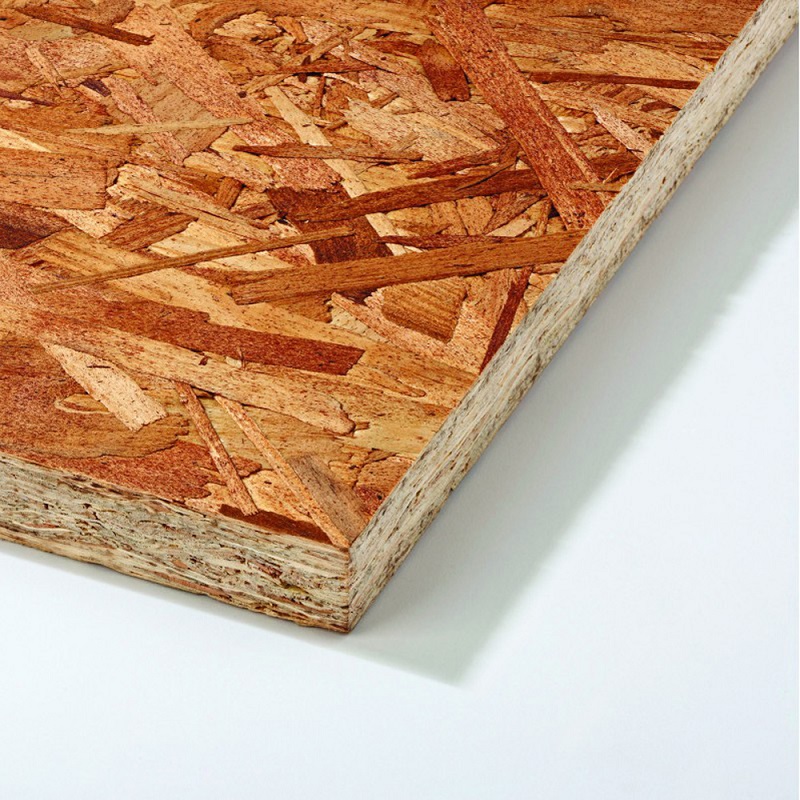Oriented strand board
Oriented strand board (OSB), also known as flakeboard or sterling board, is a type of engineered sheet timber product that is typically used as sheathing in wall panels, flooring and roof decking. OSB has similar properties to plywood, another engineered sheet timber product, and is suitable for load-bearing applications. It is less commonly used for exterior applications.
It was first developed in America in the early-1960s, and is made of layers of compressed timber strands bonded with adhesive. The individual strands – or flakes – are usually about 2.5 x 15 cm, and lie unevenly across each other, resulting in OSB’s rough and variegated surface.
OSB is typically manufactured to a ratio of 95% timber strands to 5% wax and synthetic resin adhesives (typically, moisture-resistant binders such as phenol formaldehyde (PF), urea formaldehyde (UF), isocyanate (PMDI) or a combination).
Timber strands are sifted and lain into a mat located on a forming line before being coated with the resin. The required thickness of the panel determines the number of layers that are placed. A thermal press is used to compress the mat which bonds the strands by heat activation and curing of the resin. The mat is then cut into individual sizes as required.
Impermeability to water can be achieved through the use of additional membranes.
OSB can be more cost-effective than plywood. In terms of strength, unlike natural timber there is not a continuous grain, however, it does have an axis – found with the alignment of the surface strands – along which its strength is greatest.
[edit] Related articles on Designing Buildings
Featured articles and news
RTPI leader to become new CIOB Chief Executive Officer
Dr Victoria Hills MRTPI, FICE to take over after Caroline Gumble’s departure.
Social and affordable housing, a long term plan for delivery
The “Delivering a Decade of Renewal for Social and Affordable Housing” strategy sets out future path.
A change to adoptive architecture
Effects of global weather warming on architectural detailing, material choice and human interaction.
The proposed publicly owned and backed subsidiary of Homes England, to facilitate new homes.
How big is the problem and what can we do to mitigate the effects?
Overheating guidance and tools for building designers
A number of cool guides to help with the heat.
The UK's Modern Industrial Strategy: A 10 year plan
Previous consultation criticism, current key elements and general support with some persisting reservations.
Building Safety Regulator reforms
New roles, new staff and a new fast track service pave the way for a single construction regulator.
Architectural Technologist CPDs and Communications
CIAT CPD… and how you can do it!
Cooling centres and cool spaces
Managing extreme heat in cities by directing the public to places for heat stress relief and water sources.
Winter gardens: A brief history and warm variations
Extending the season with glass in different forms and terms.
Restoring Great Yarmouth's Winter Gardens
Transforming one of the least sustainable constructions imaginable.
Construction Skills Mission Board launch sector drive
Newly formed government and industry collaboration set strategy for recruiting an additional 100,000 construction workers a year.
New Architects Code comes into effect in September 2025
ARB Architects Code of Conduct and Practice available with ongoing consultation regarding guidance.
Welsh Skills Body (Medr) launches ambitious plan
The new skills body brings together funding and regulation of tertiary education and research for the devolved nation.
Paul Gandy FCIOB announced as next CIOB President
Former Tilbury Douglas CEO takes helm.
UK Infrastructure: A 10 Year Strategy. In brief with reactions
With the National Infrastructure and Service Transformation Authority (NISTA).























